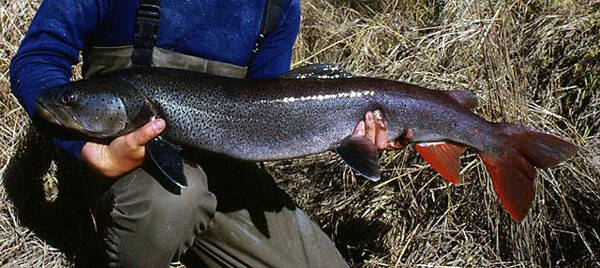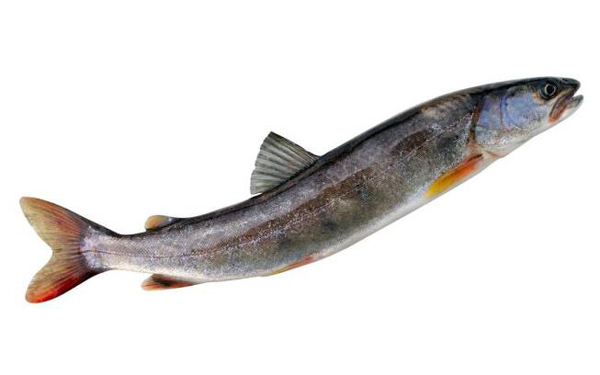Taimen (scientific name: Hucho taimen) is a cold-water carnivorous freshwater fish of the family Salmonidae and the genus Hucho.

Taimen spends most of its time in fast-flowing streams, hibernates in deeper waters such as major rivers and lakes in winter, and migrates to streams in spring to spawn. Taimen are pure freshwater cold-water fish, and spend most of their time in mountain streams with low temperatures (below 20℃), high dissolved oxygen, coarse sand or gravel bottom, deep and fast currents, clear water, and lush vegetation on both sides. In summer, they mostly live in tributaries in mountain forests. In late autumn and winter, affected by the water level, they gradually swim to deeper water bodies before ice forms to find suitable places to overwinter. After the river opens in spring, they migrate to mountain streams for reproduction, and move to the main stream after August.

Taimen is very greedy and is one of the most ferocious freshwater fish. It swims fast and is good at chasing and preying on fish. It feeds all year round, and its appetite is still strong in winter. It only feeds less when the water temperature rises in summer or during the breeding season, or even stops feeding. It stops feeding during the reproductive period. The foraging time is mostly before sunrise and after sunset. They swim from deep water to shallow water shores to prey on fish or snakes, frogs, mice and water birds (mostly cold-water fish, and the fish they feed on varies depending on the ecological environment of the waters they inhabit). At other times, they lurk in the shaded water on both sides of the stream. The juvenile Taimen mainly prey on benthic invertebrates.
Taimen matures at the age of 5, with a body length of 40-50 cm. They can reproduce many times a year. Male individuals mature at the age of about 4 years. The reproductive period begins in mid-May, with a water temperature of 5-10℃. Parents gather in small rivers with fast-flowing water and gravel and sand to lay eggs. The number of eggs is 10,000 to 34,000, with an average of 220,000. The mature eggs are light yellow, round, non-sticky, and 3.5-4.5 mm in diameter. Parents have the habit of burying eggs and protecting nests. After spawning, they die in large numbers, especially male fish. Fertilized eggs hatch after 30-35 days. Fry likes to lurk in the gaps between gravel and rarely swim.
Studies have shown that young Taimen feed on small fish, and big fish often eat wild waterfowl such as wild ducks floating on the water surface, as well as otters and large water rats in the lake. Ichthyologists once believed that giant Taimen had become extinct in the world, but unexpectedly found their traces in Kanas Lake. In June 2005, the mysterious Kanas "lake monster" appeared frequently. On the morning of June 21, 2012, an unidentified creature suspected of being a lake monster appeared in Kanas Scenic Area in Xinjiang, China, causing huge waves. Yuan Guoying, chairman of the Xinjiang Ecological Society and researcher at the Xinjiang Institute of Environmental Protection Sciences, believes that the "lake monster" and "water monster" must be Taimen.
A natural hybrid of Taimen and Salmo salar caught in the Huma River in the upper reaches of the Heilongjiang River in China in the 1950s. Artificial breeding of Taimen and Salmo salar has been declared successful in China and is in the stage of artificial propagation. Many Chinese scholars have done a lot of research on the artificial breeding, domestication, biological characteristics, genetics and molecular biology of these two fish. In 2007, the Heilongjiang Fisheries Research Institute had solved the problem of hybridization between the two fish genera and obtained a large number of hybrid fry and young fish. The Bohai Cold Water Fish Experiment Station of the Heilongjiang Fisheries Research Institute successfully carried out artificial breeding in 2005 and obtained artificially domesticated fry.
Listed in the IUCN Red List of Threatened Species in 2013, ver 3.1 - Vulnerable (VU).
Listed in the China Red Data Book of Endangered Animals (Fish).
Russia and Mongolia list the Taimen as a Class V endangered protected animal, equivalent to Class I in China.
Listed in the Class II List of China's National Key Protected Wildlife. (Wild populations only)
Protect wild animals and stop eating game.
Maintaining ecological balance is everyone's responsibility!